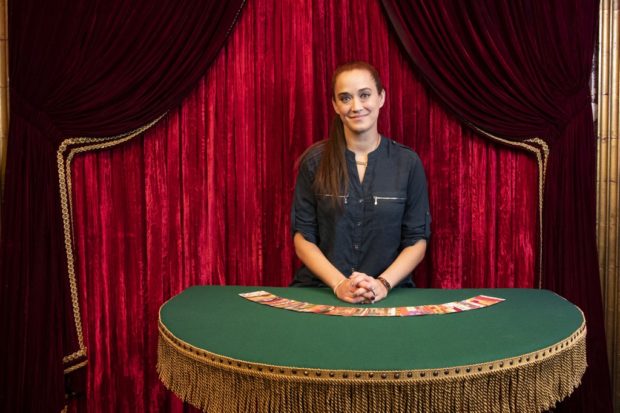
Magician Kayla Drescher poses before her performance at the Magic Castle, in Hollywood, California on Oct. 13, 2021. (Photo by VALERIE MACON / AFP)
LOS ANGELES—Sitting behind a card table in the secretive Magic Castle, Kayla Drescher widens her eyes and nods exasperatedly when asked about being called a “female magician.”
“Yes, I am very, very sick of being asked what it’s like to be a woman in this industry,” she says.
“‘Female magician’ feels like I’m being placed in a subcategory of magic … I’m being placed in a metaphorical box, not just an illusion.”
But while the label is “exhausting” and “annoying” for Drescher, “we still have such a small percentage of women in this industry — I think it does still need to be talked about.”
The stereotype of a magician in a top hat sawing his glamorous, sequinned female assistant in half endures among the wider public, who can rarely name performers beyond Harry Houdini, David Copperfield, and David Blaine.
While the outfits have changed, still just 7 percent of magicians operating today are female — roughly the same proportion as the membership of the elite “Academy of Magical Arts” that calls the Magic Castle home.
Drescher is one of two billed female headliners on the night of the Agence France-Presse’s (AFP) visit to the cavernous members-only institution on a hill above Hollywood, which is devoted to the art of illusion.
As the reaction of a spellbound audience to Drescher’s baffling card tricks and subtle sleights of hand later in the evening will show, women may be a minority in magic but are no less of a draw.
Drescher, 31, has been performing since she was 7, and has long found that audiences—like the aficionados and rowdy wine-drinking Halloween parties filling the “Close Up Gallery”—tend not to care about a performer’s gender.
Instead, it is the “shocking old-fashioned” mind-set of magicians that is keeping the number of women in her trade low—and that is something she feels is important to keep “yelling about.”
Drescher has long dealt with male magicians excluding her, assuming she is someone’s girlfriend, or even one time requesting she “do magic by a poolside in a bikini” in Las Vegas.
“Magic is very much written by men and for men, so suits, large trouser pockets, big hands, all these different elements, very masculine-style stuff,” said Drescher, who hosts the “She-zam” podcast.
“You have to get through, jump over, a lot of hurdles in order to be respected in the community for being a magician and not just a woman. And that’s always annoying.”
According to Drescher, if the assistant could just as easily be replaced with an inanimate object like a lamp or a table “she doesn’t need to be there … she’s a prop.”
“The mutilation of women … “ she sighs. “It just feels really gross in 2021. But luckily it is shifting.”
The last few years and #MeToo have massively boosted demand for female magicians, says Drescher.
But built-in obstacles remain, including the powerful status of reform-resistant, generally male-dominated magic “clubs.”
The Academy of Magical Arts itself faced allegations of sexual harassment in a Los Angeles Times investigation last year.